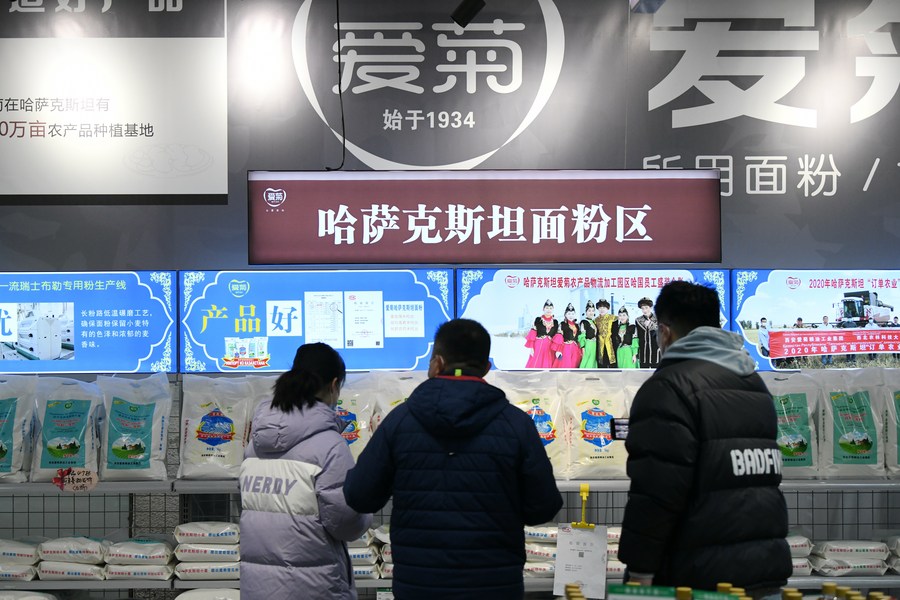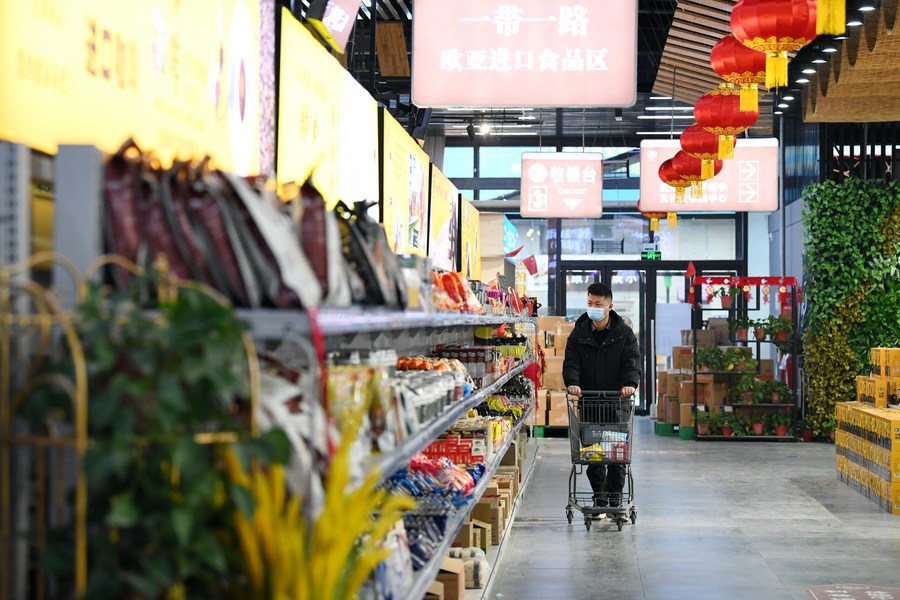
A China-Europe freight train is seen at Xi’an International Port in Xi’an, northwest China’s Shaanxi Province, March 23, 2023. (Xinhua/Li Yibo)
When Juan Carlos in Malaga, Spain, ordered a made-in-China ceiling light using the cross-border e-commerce platform AliExpress, he never imagined he would receive the product the next day.
“I have to admit, that was faster than I expected,” said Carlos in surprise.
The ceiling light came from a warehouse belonging to Qxbox Technology Warehousing Ltd. in Madrid, which explains the rapid delivery. However, like 100,000 other products at the warehouse, it had already traveled over 5,000 miles from China. The speedy shopping experience of Carlos and millions of other Europeans like him would be impossible without highly efficient logistics.
Departing from their point of origin in south China’s Guangdong Province, these items were first transported overland to a distribution hub in Xi’an, capital city of northwest China’s Shaanxi Province. They then headed to Spain via Chang’an China-Europe freight trains.
“Before 2017, it took more than 40 days to transport goods by ship. But freight train services help us to cut the time in half, and at a lower cost,” said Mou Jinwen, chairman of Qxbox.
About 2,000 years ago, in the Han Dynasty (202 B.C.-25 A.D.), a Chinese envoy named Zhang Qian began his expedition to the Western Regions, and opened up a trade route that later became the Silk Road.
In 2013, China put forward the Belt and Road Initiative (BRI). Since then, the China-Europe freight train service was launched, becoming the modern day “steel camel caravans” linking 108 Chinese cities with 208 European cities in 25 countries.

Customers select flour products from Kazakhstan at a store in Xi’an International Trade and Logistics Park in Xi’an, northwest China’s Shaanxi Province, Jan. 13, 2023. (Xinhua/Li Yibo)
Qxbox worked with local delivery companies and built four warehouses around the world. The one in Madrid covers an area of 12,000 square meters, handling an average of 6,000 orders per day. Buyers can receive their packages within two days.
Moreover, by cooperating with e-commerce platforms like Amazon and AliExpress, it provides overseas customer service, after-sales repair, return and exchange to domestic companies.
Diego Cimadevilla, management director of Qxbox’s subsidiary in Spain, noted that the competitive edge of freight train services lies in sustainability, stability and security. Meanwhile, Spanish products also have access to the Chinese market that is both quick and cost-effective.
According to a report released by China’s General Administration of Customs (GAC), the value of China’s cross-border e-commerce imports and exports reached 2.1 trillion yuan (about 295 billion U.S. dollars) in 2022, marking an increase of 7.1 percent compared with 2021.
The Xi’an International Trade and Logistics Park, where Chang’an China-Europe freight trains depart, has attracted many foreign trade enterprises and logistics suppliers.

A customer selects imported food at a store in Xi’an International Trade and Logistics Park in Xi’an, northwest China’s Shaanxi Province, Jan. 13, 2023. (Xinhua/Li Yibo)
Sitting before a camera, Tagenova Selle, a 23-year-old live-streamer from Georgia, touts glistening earrings and necklaces to her viewers in fluent English.
“After choosing your favorite designs, you just need to click the mouse to complete the payment. The package will be shipped directly to your home, and you can also enjoy a 14-day goods return policy,” said Selle.
Selle’s company, Weiju Fanxing Global Cross-border Live Broadcast Base, was set up in the Xi’an International Trade and Logistics Park early this year. Currently, it has nearly 80 live-streamers from home and abroad who perform 50 livestreaming sessions every week, selling products to overseas customers.
“The base’s parent company already has branches in Shanghai, London and Los Angeles. As we began to focus more on overseas markets, we decided to set up a cross-border live-streaming center in Xi’an as the city’s Chang’an China-Europe freight train service helps us have easy access to a complete supply chain and low-cost international delivery services,” said Wang Fang, who is in charge of the base.
In 2022, the Chang’an China-Europe freight train made 4,639 train trips, 198 of which were dedicated to the cross-border e-commerce business, an annual increase of over 60 percent. It covers locations producing goods in Asia and Europe, like Mannheim, Prague and Milan, with 17 international routes.
Ten years on, BRI has evolved into a mutually beneficial program, with improving cross-border collaboration. Jumekenova Anita, a Kazakh entrepreneur, and her husband Yuan Zhaohui from China have felt it deeply.
Starting from a brick-and-mortar store in Karaganda, Kazakhstan, they founded a cross-border e-commerce platform called Silkroad City Shop and built six warehouses in Kazakhstan, Russia and Belarus, and cooperated with more than 300 Chinese suppliers and 2,000 Kazakh delivery stations.
They also teamed up with over 2,000 local online influencers in Kazakhstan to promote products. “Just pick up your mobile phone to shoot and share videos about the products, and you can get a commission. It provides local young people with opportunities for employment and business start-ups,” said Anita.
“We are fortunate to benefit from BRI and Chang’an China-Europe freight train services, and we hope to bring benefits to more people along the route,” added by Anita.
Source: Xinhua News Agency
*This article is from Belt and Road Portal
